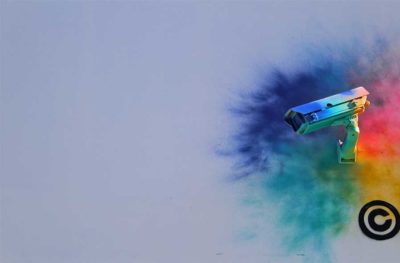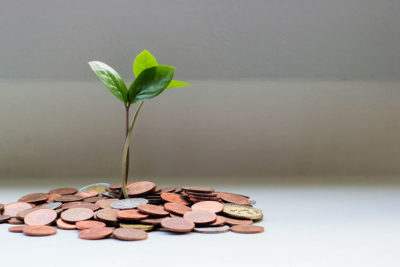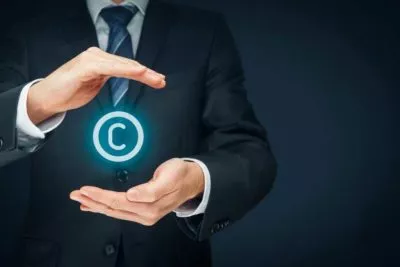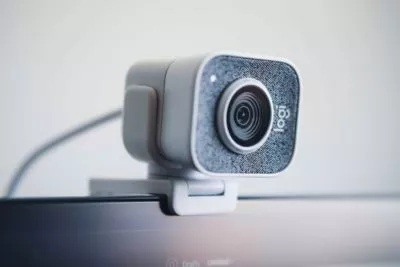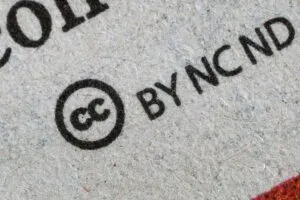
What is Copyright Infringement? Elements, Examples, & Defenses
This page has been peer-reviewed, fact-checked, and edited by qualified attorneys to ensure substantive accuracy and coverage.
Unfortunately, it is not uncommon for photographers, videographers, writers, and other artists to find unlawful copies of their work being sold or distributed online. Even if you are not a professional artist, your creative works belong to you—and discovering that someone infringed on your original works can be highly distressing. This unlawful behavior is known as copyright infringement.
U.S. copyright law protects creators of original, creative works from having their intellectual property used by others. Copyright infringement is the reproduction, distribution, or alteration of a creative work without the owner’s permission. Common examples of copyright infringement against you might include:
- Uploading your photos to the internet,
- Stealing licensed software from your website,
- Plagiarizing your written text, and
- Using substantial parts of your song in a new recording without attributing you.
Our team at Minc Law has proven experience sending DMCA takedown notices, issuing cease and desist letters, and filing copyright infringement lawsuits on behalf of our clients to protect their creative works. Through our work, we have successfully removed more than 50,000 pieces of defamatory and infringing content from the internet. We analyze copyright claims and prepare the most effective legal strategy to help clients protect their intellectual property, with or without litigation.
In this in-depth guide, we explain the definition and elements of copyright infringement. We then break down the different infringement types, explore how to prove copyright infringement, and list the typical defenses to an infringement claim. We then provide actionable strategies for victims to fight back against copyright infringement.
Understanding Copyright Infringement
Contrary to popular belief, a work does not need to be registered with the U.S. Copyright Office to be protected by a copyright. Any creative work—from an Instagram photo to a bestselling novel—is protected by U.S. copyright law. In this section, we explain what a copyright is and how it can be infringed upon.
What is a Copyright?
Copyrights protect original, creative works of authorship captured (or “fixed”) in a tangible medium. For example, an original work of authorship could be in photo, video, drawing, or text form. If an individual publishes a copyrighted work without consent from the author, they have violated copyright.
How is a Copyright Different From a Trademark?
Trademarks and copyrights are two types of intellectual property rights. Trademarks protect symbols, words, or logos that represent a business. They are designed to protect brand assets and distinguish businesses from each other.
Copyrights, on the other hand, protect creators’ original, creative works. They are not limited to brand assets.
What Rights Does a Copyright Owner Enjoy?
Under 17 U.S.C. § 106, a copyright owner has the exclusive right to do and authorize any of the following:
- Reproduce or copy the work;
- Distribute copies of the work to the public via sale, rent, or lease;
- Create derivative works;
- Perform the work publicly;
- Display the work publicly; and
- Publicly perform sound recordings of the work.
How Long Does Copyright Protection Last?
Copyright protection length depends on several factors, such as the date the work was created and who authored the work. Generally, creations made after 1978 are protected throughout the author’s life and seventy years after their death.
Joint creations by two or more authors have copyright protection until 70 years after the last surviving author’s death. Works for hire, anonymous works, and works made under a pseudonym are protected for 95 years from first publication or 120 years from creation (whichever is shorter).
Does a Copyright Extend to Other Countries?
Copyright law in the U.S. is governed by federal statute, specifically the Copyright Act of 1976. Copyright protection in other countries depends on the national laws of each country where you seek protection.
Several international treaties have also established laws for copyright protection that apply to any country that is a party to that treaty. For example, the World Intellectual Property Organization Copyright Treaty (1996) protects authors’ rights in a digital environment, including protection for computer programs and databases.
Definition of Copyright Infringement
Copyright infringement occurs when an original, creative work is copied, distributed, performed, displayed, or made into a derivative work without the owner’s permission. It can look like uploading another person’s copyrighted material to the internet, modifying a copyrighted image, or using protected lyrics, writing, or images without permission.
Other common examples include:
- Unlawfully downloading music,
- Recording a movie illicitly in a theater,
- Obtaining licensed software from an unauthorized website,
- Using another person’s photos on a website or blog without their consent,
- Using a copyrighted song on your company website or social media posts, and
- Selling merchandise that contains copyrighted logos, text, or images.
For further reading, please see our comprehensive article explaining ‘What to Do If Someone Has Stolen Your OnlyFans Content’.
We can help. Learn your legal options today.Dealing with copyright infringement?
Elements of a Copyright Infringement Claim
If your copyrighted material is being unlawfully used, a copyright infringement lawsuit may be the only way to force the perpetrator to stop their harmful behavior. In this section, we describe the main elements you must prove to bring a successful copyright infringement claim.
Ownership of a Valid Copyright
First, you must prove that you have ownership of a valid copyright. Unlike other types of intellectual property, such as trademarks and patents, a copyright does not need to be registered with the US Copyright Office to be valid.
How a Copyright is Acquired
A work acquires copyright as soon as you create it, as long as it contains a sufficient degree of originality. It must also be fixed in a “tangible form of expression,” such as text or an audio/video recording.
Copyright Registration Process
While not required, registering your copyright with the U.S. Copyright Office can be beneficial. A public record of the copyright claim can make it easier to protect your work against potential infringement. Before filing an infringement suit, you must have registered your copyright beforehand.
To register a copyright claim with the U.S. Copyright Office, follow these steps:
- Submit a completed application,
- Pay a non-refundable fee (see this list of fee types for more information), and
- Deposit the required number of copies of the creative works you want to register.
Copying or Reproducing the Work
Under the Copyright Act, only the copyright owner has the exclusive right to reproduce their work or authorize reproduction. When bringing a claim for copyright infringement, you must show that your copyrighted work has been copied, reproduced, or otherwise used in a way that violates your exclusive rights under the Copyright Act.
Definition of Copying & Reproduction
The Copyright Act covers reproduction in any form, including:
- Photocopying a book,
- Copying computer software,
- Using a copyrighted character on a product, and
- Incorporating part of a copyrighted song into a new song.
Infringement can occur whenever the copying is deemed substantial and material. The entire work does not need to be copied to constitute infringement.
Use of Copyrighted Work Without Permission
A claim for copyright infringement must also show that the alleged infringer did not have permission to use the copyrighted work.
Substantial Similarity Requirement (Between the Original & Alleged Infringing Work)
The owner of the copyrighted work must also show that the original and infringing works are substantially similar. This requirement is meant to establish that the alleged infringer actually copied the protective work and that the amount copied is enough to constitute misappropriation.
Assessment of Substantial Similarity
To prove copyright infringement, the plaintiff must show the following:
- The defendant had access to the plaintiff’s copyrighted work, and
- The defendant’s work is substantially similar to the protected aspects of the plaintiff’s work.
There is no exact test to determine if two works are substantially similar, and courts apply various determining factors within the context of each particular case. For example, copying one line from a long novel would likely not be considered substantially similar. However, copying multiple paragraphs or chapters would support an argument that a substantial amount of the original work had been copied.
A court might also analyze specific elements of the work (like structure, characters, settings, and language). They may also consider an ordinary person’s impression of the similarities between the two works.
Types of Copyright Infringement
There are several forms of copyright infringement based on the infringer’s relationship to the material. Below, we explore four of the most common types:
- Direct,
- Contributory,
- Vicarious, and
- Online.
Direct Copyright Infringement
Direct copyright infringement is the simplest type of copyright infringement. It is a violation of the copyright owner’s exclusive rights to the reproduction, distribution, performance, public display, or derivative creation of a copyrighted work.
Unauthorized Reproduction or Distribution of Copyrighted Work
Per 17 USC § 106, a copyright owner has the exclusive rights to reproduce or distribute their copyrighted work via:
- Sale,
- Transfer of ownership,
- Rental, or
- Lease.
Reproducing or distributing a copyrighted work without authorization is a direct violation of the Copyright Act and constitutes infringement.
Making Derivative Works Without Permission
The Copyright Act also gives copyright owners the exclusive right to make derivative works based on the original copyrighted work. Common examples include translations into another language or adaptations into another medium, such as:
- A motion picture version of a literary work,
- Dramatizations,
- Fictionalizations,
- Artistic reproductions,
- Abridgments, or
- Condensations of preexisting works.
Derivative works can also include modifications to an original work, like editorial revisions, annotations, or other changes depending on the original work’s medium. Because the right to create derivative works belongs exclusively to the copyright owner, the unauthorized transformation of a copyrighted work constitutes direct infringement.
For example, in the landmark copyright infringement case Rogers v. Koons, photographer Art Rogers took a photo of a couple holding puppies and sold it for use in greeting cards. Artist Jeff Koons created and sold a series of statues based on Roger’s photo. The court held that this activity was copyright infringement because an ordinary person could recognize the similarities. Thus, Koons’ sculptures were considered to be unauthorized derivative works.
Contributory Copyright Infringement
Contributory copyright infringement is a secondary liability where a person can be held liable for infringement even if they did not directly engage in the unlawful activities. An individual can be liable for contributory infringement when they know about the infringing activity and induce, cause, or contribute to it.
Facilitating or Enabling Others to Infringe Copyrights
The Copyright Act itself does not explicitly address liability for contributory infringement. However, the U.S. Supreme Court has held that a party can be liable as a contributory infringer if they knew (or had reason to know) about the infringing activities.
For example, if a founder of a music-sharing website personally encouraged employees to take songs from sites dealing in pirated music, such encouragement would be considered facilitating the infringing activities.
Knowledge & Material Contribution to the Infringement
A plaintiff bringing a contributory infringement claim must prove the defendant knew about the infringing activity. Different courts have applied different standards of knowledge to this claim.
Some courts have held that the defendant must have actual knowledge of the activities, while others have held that if they “should have known” or were simply willfully blind, that standard was enough.
The plaintiff must also show that the defendant caused or materially contributed to the infringement. Here, courts focus on the defendant’s actions, such as if they encouraged or assisted others’ infringing activity.
Vicarious Copyright Infringement
To be liable for vicarious copyright infringement, a party must have the right and ability to control the infringing activities—and derive a direct financial benefit from those activities.
Benefitting From & Having the Ability to Control Infringing Activities
If you want to bring a claim for vicarious infringement, you must show that the defendant had a legal right to control, stop, or limit the infringing conduct. You must also demonstrate that they had the practical ability to do so.
The defendant must also have benefitted from the infringement in a directly traceable way. For example, you could demonstrate that the infringement resulted in new customers or profits for the defendant’s business.
Relationship Between the Infringer & Direct Infringer
Vicarious liability for copyright infringement typically includes situations where a principal (such as an employer) is responsible for their agents’ or employees’ actions.
In the case of Dreamland Ballroom, Inc. v. Shapiro, Bernstein & Co., for example, a dance hall hired an orchestra that performed unauthorized works. The court held the dance hall vicariously liable for the orchestra’s infringement.
Online Copyright Infringement
Online copyright protection extends to works appearing online that meet the prerequisites for Copyright Act protection. The work must be an original work of authorship with some creative spark that is fixed in a tangible medium.
The “fixation” requirement includes any electronically readable format, such as:
- A blog post,
- Emails,
- Storage in computer memory,
- Audio recordings,
- Video footage, and
- Image files on a website.
Overview of Copyright Infringement in the Digital Age
Generally, the Copyright Act protects copyrighted content on the internet in the same way it protects physical works like books or art. Amendments to the Copyright Act address the relationship between copyright law and the internet.
Passed in 1998, the Digital Millennium Copyright Act (DMCA) provided three primary updates to the Copyright Act:
- Establishing protections for online service providers if their users engage in copyright infringement, including the notice-and-takedown system detailed below;
- Encouraging copyright owners to give greater access to their works digitally while providing legal protection against unauthorized access to those works, such as hacking or circumventing encryption;
- Making it unlawful to provide false copyright management information, including fake names of copyright owners or false titles of works. It also made it unlawful to remove or alter copyright management information in certain situations.
Online Platforms & Their Responsibility For Copyright Infringement
The DMCA’s notice-and-takedown system provides relief for online service providers who might otherwise be held vicariously liable for their users’ copyright infringement. Under the DMCA, a provider can qualify for safe harbor protections from liability if they:
- Adopt and reasonably implement a qualifying repeat infringer policy, and
- Do not interfere with standard technical measures defined by Section 512 of the Copyright Act.
With such safe harbor protections, online service providers are not required to monitor their servers actively for infringing content. However, once a provider receives a complaint meeting the DMCA’s notice-and-takedown requirements, they must immediately remove or disable access to the infringing material. The service provider must also promptly notify the user who originally uploaded the material that it has been removed.
Common Defenses to Copyright Infringement
A claim for copyright infringement must also show that the alleged infringer did not have permission to use the copyrighted work. The most common defenses to a claim for copyright infringement include:
- Fair Use Doctrine,
- Proof of work in the public domain,
- Proof of license or permission, and
- Proof of independent creation.
We explore each defense in greater detail below.
Fair Use Doctrine
A common copyright infringement defense is that the use of the copyrighted work falls under the exceptions listed in the Fair Use Doctrine. The purpose of the Fair Use Doctrine is to promote freedom of expression by permitting unlicensed use of copyrighted work in certain circumstances.
Overview of Fair Use as a Defense to Copyright Infringement
According to the Copyright Act, the Fair Use Doctrine permits the unlicensed use of copyrighted works in situations such as:
- Criticism,
- Comment,
- News reporting,
- Teaching,
- Scholarship, and
- Research.
Factors Considered in Determining Fair Use
Courts primarily consider four factors when analyzing whether an activity falls under the Fair Use Doctrine.
First, they consider the purpose and character of the use, such as if it is for commercial or nonprofit purposes. “Transformative” uses that add a new purpose or character to the work are more likely to be considered Fair Use.
Then, courts take into account the nature of the copyrighted work. Imaginative works (such as movies, songs, and novels) are less likely to be considered Fair Use than factual works like news articles.
Courts also consider the amount and substantiality of the used portion compared to the copyrighted work as a whole. Generally, using a small amount of copyrighted material is more likely to be considered Fair Use.
Finally, Fair Use depends on the effect on the potential value of the copyrighted work. Courts consider whether the use hurts the current market for the original work or if it could cause substantial harm if it becomes widespread.
Courts may also consider other factors on a case-by-case basis determined by the specific facts of a given claim. For example, in the case of Fairey v. Associated Press, famous street artist Shepard Fairey created the “Hope” poster during President Obama’s run for office. However, he used a photograph taken by a freelance photographer with the Associated Press. Fairey argued Fair Use, claiming his work did not reduce the value of the original photograph. The case ended in a private settlement but significantly contributed to the discourse around valuing a work when analyzing Fair Use.
In Cariou v. Prince, another famous example, Richard Prince was a well-known artist who often transformed the work of others to create new meanings. He appropriated 41 images from Patrick Cariou’s photography book, adding changes in color and new details to the images. The court eventually ruled in Prince’s favor, claiming the images were transformed in a way that created a different aesthetic. The use was thus acceptable under the doctrine of Fair Use.
Public Domain Works
Works in the public domain are no longer under copyright protection and thus can be used freely without the former copyright owner’s permission. A work may enter the public domain when:
- The copyright has expired,
- The owner has not renewed (or failed to renew) the copyright,
- The owner has deliberately dedicated the work to the public domain, or
- The work is not protected by copyright law, to begin with.
Once a work is in the public domain, anyone may copy, modify, translate, distribute, perform, or display the work without seeking permission. Works in the public domain include those published before 1929 and some published between 1928 and 1977, depending on whether the copyright was renewed or if the work was published without a copyright notice.
Along with Fair Use, licensing, and the Public Domain, other exceptions to the copyright law permission requirement include:
- Library or archival reproduction,
- Face-to-face teaching, and
- Reproduction and distribution of copyrighted works in accessible formats for people with disabilities.
License & Permission
If the defendant can prove they had permission to use a copyrighted work, they can also likely defeat an infringement claim.
Obtaining Proper Authorization for Using Copyrighted Works
If a work is under copyright protection, the easiest way to obtain permission to use it is usually by asking the copyright owner. These requests may include payment negotiations and specifications for use—and they should always be stated in writing. In a copyright lawsuit, defendants can use such written agreements to defeat the infringement claim.
Effect of Licenses & Permissions
A license or permission to use a copyrighted work can impact the user’s rights differently depending on the specific permissions. For example, a license for use might only cover one of the exclusive rights listed in the Copyright Act. It may give the user the right to create a derivative work but not to distribute copies of the original work.
Licenses may also be exclusive, nonexclusive, or only apply for a certain timeframe or within a specific geographic area. These details can be crucial to determining whether proof of permission is enough to defeat a copyright infringement claim.
Using copyrighted work without permission can result in a lawsuit against the infringer. For example, in 1991, musical artist Vanilla Ice released the song “Ice Ice Baby,” featuring a sample of “Under Pressure” by David Bowie and Queen. Because Vanilla Ice did not have the appropriate permission to use part of the copyrighted song, Bowie and Freddie Mercury sued Vanilla Ice for infringement. The case was eventually settled privately outside of court.
Independent Creation
If the defendant can prove that they created their work independently—without copying elements of the original work—they can also defeat a claim for copyright infringement. Independent creation is not an affirmative defense, but it can negate the plaintiff’s alleged evidence of copying.
Demonstrating Alleged Infringing Work Was Independently Created
The independent creation defense is established by showing that the allegedly infringing work was created without copying the plaintiff’s work. For example, written records from the defendant’s creation proving they were inspired by something other than the copyrighted material may be sufficient to establish this defense.
Lack of Access to Copyrighted Work
A defendant may also establish the independent creation defense by proving a lack of access to the copyrighted work. If they can prove they never had access to the copyrighted material in the first place, it may be sufficient to prove their work was independently created.
It is important to note that some courts still consider “subconscious” or “innocent” copying as infringement. For example, if the defendant heard the plaintiff’s song at an earlier time and then later unintentionally created a substantially similar song, a court may find that new song to be an infringement.
How to Address Copyright Infringement
If you believe your copyrighted work is being infringed, there are several ways to address the copyright violation, including:
- Sending a cease and desist letter,
- Issuing a DMCA takedown notice, and
- Filing a lawsuit for copyright infringement.
Cease & Desist Letters
Sometimes the simplest course of action is to have your attorney send a cease and desist letter demanding that the infringer stop their behavior immediately. These letters often provide notice that you may take further legal action, such as a lawsuit, if the alleged conduct continues.
Although these letters are non-binding on their own, they can be used as evidence in court that the defendant had been notified that their conduct constituted copyright infringement.
DMCA Takedown Notices
If your copyrighted work has been published to the internet by a third-party user, a DMCA takedown notice might be an effective way to have the infringing content taken down.
The Process of Issuing a DMCA Takedown Notice
DMCA takedown notices should be sent to the service provider responsible for the website. If you cannot easily identify the website host, try using Whois Lookup from Domain Tools, which lets you search domain ownership information and IP address history.
Once the relevant online service provider receives a letter meeting DMCA requirements, they must take action to remove (or disable access to) that content.
Requirements For a Valid DMCA Takedown Notice
Valid DMCA takedown notices must contain these elements at a minimum:
- The copyright owner’s signature (or the signature of their authorized agent);
- Identification of the copyrighted work(s) in question;
- Identification of or link to the infringing material and reasonably sufficient information for the service provider to find it;
- The copyright owner or authorized agent’s contact information;
- An explanation of your good faith belief that the copyright owner, their agent, and the law did not authorize the material’s use; and
- A statement under penalty of perjury that the notice is accurate and that the sender is authorized to act on the copyright owner’s behalf.
DMCA takedown notices are simple, but they are not one-size-fits-all. It is always best to have an experienced DMCA attorney help you draft a takedown letter to ensure it is as effective as possible. For further reading, please see our comprehensive resources ‘How to Send an Effective DMCA Takedown Notice’ and ‘How Much Does a DMCA Takedown Notice Cost?’
Lawsuits For Copyright Infringement
A copyright owner may sue an infringer to enforce their exclusive rights to the copyrighted work. Because the Copyright Act is federal law, these lawsuits must be brought in federal district court.
Initiating a Lawsuit Against the Infringer
To bring a lawsuit for copyright infringement, you must provide proof of copyright ownership and that the defendant violated your exclusive rights to your copyrighted work. Plaintiffs often establish proof by showing substantial similarity between the two works.
A copyright does not need to be officially registered to be valid. However, a work registered with the Copyright Office can make it easier to establish infringement when filing a lawsuit.
Damages & Remedies Available to Copyright Holders
If you can successfully prove copyright infringement, you may recover actual damages, the infringer’s profits, and statutory damages.
Actual damages are measured by the work’s “lost market value” at the time of the infringement. Profits are established by the infringer’s gross revenue minus expenses and elements of profit that can be attributed to outside factors.
A copyright owner may also elect to recover statutory damages for all infringements ranging from $750 to $30,000.
Injunctions to Prevent Further Infringement
Injunctive relief, where the court restrains the defendant from taking specific actions, is also available to plaintiffs in copyright infringement cases. Under 17 USC § 502, a court may grant temporary and final injunctions to prevent further infringement on a copyright.
Criminal Consequences
Federal prosecutors have a five-year statute of limitations to bring a criminal case against an infringer. The copyright must be registered, and the prosecutor must show that the defendant willfully infringed for the financial gain of more than $1,000 during a 180-day period.
Alternatively, the prosecutor must show the defendant publicly distributed a work online that was intended for commercial distribution.
Criminal Penalties For Willful Copyright Infringement
First-time offenders convicted of distributing at least ten copies of a work with a retail value of over $2,500 can be imprisoned for up to five years and fined up to $250,000 (or both). These penalties increase to a maximum of ten years in prison, up to $250,000 in fines, or both for anyone previously convicted of criminal copyright infringement.
Misdemeanor copyright infringement carries penalties of up to one year in prison and a maximum fine of $100,000.
Finally, first-time offenders convicted of circumvention of access controls or trafficking in technology to circumvent copyright controls can be fined up to $500,000, imprisoned for up to five years, or both. For subsequent offenses, you can be fined up to $1,000,000, imprisoned for up to 10 years, or both.
Enforcement by Law Enforcement Agencies
Because the Copyright Act is federal law, criminal prosecution of copyright infringement is enforced by the U.S. Department of Justice. The two most significant factors a federal prosecutor considers when deciding to prosecute an intellectual property infringement case are the seriousness of the offense and the likelihood of successful prosecution.
Intellectual property crimes may be reported to the following agencies:
- National Intellectual Property Rights Coordination Center,
- Federal Bureau of Investigation, and
- Internet Crime Complaint Center (IC3).
State or local task forces can also be appropriate contacts for reporting cases that do not meet the federal criminal thresholds. These task forces may include:
- InfraGard,
- The Secret Services’ Electronic Crimes Task Force, and
- Other DOJ-funded Intellectual Property Enforcement task forces.
We Help Creators Remove Copyrighted Work
If you are a creator who has found your creative work(s) unlawfully distributed or published online, it can be difficult to know how to approach removal. At Minc Law, we can help.
We have extensive experience working with both individuals and businesses to remove copyrighted and other damaging content from the internet. We help creators identify the scope of all unlawfully published content online, determine if sending a DMCA notice is the most appropriate option, send DMCA takedown notices on their behalf, and navigate internet search engines and other website reporting procedures to remove the content.
We also help individuals and businesses preserve anonymity, and mitigate the potential of drawing unwanted attention to the matter.
★★★★★
“Absolutely outstanding! Minc Law resolved my copyright infringement case, which had been languishing for over five years, in under six months. Superb outcome, lovely people, cannot recommend the firm highly enough!”
Sonya D.
March 15, 2021
If you are ready to move forward with a DMCA request or content removal, reach out to schedule your initial, no-obligation consultation by calling us at (216) 373-7706, speaking with a Chat representative, or filling out our online contact form.
Citations
17 U.S. Code § 110 - Limitations on exclusive rights: Exemption of certain performances and displays

